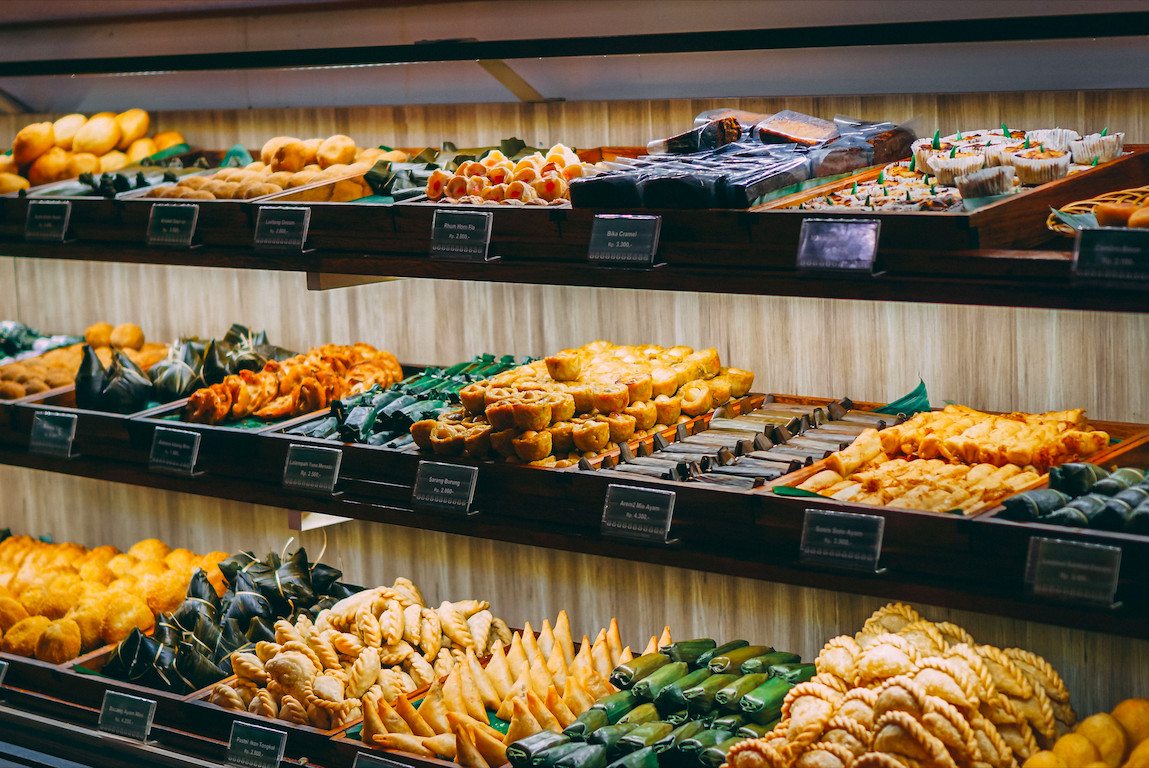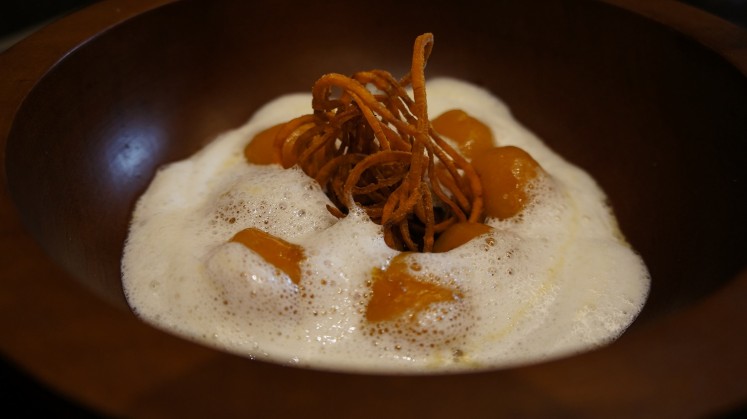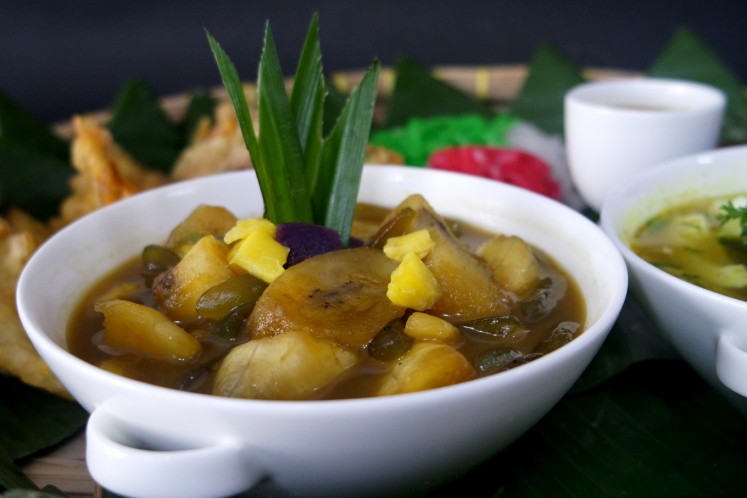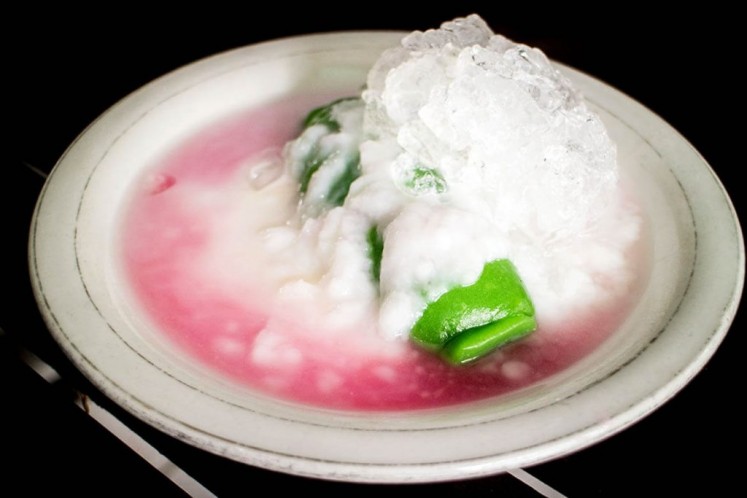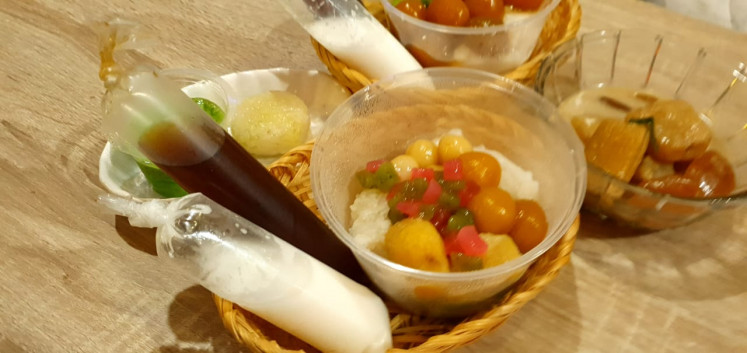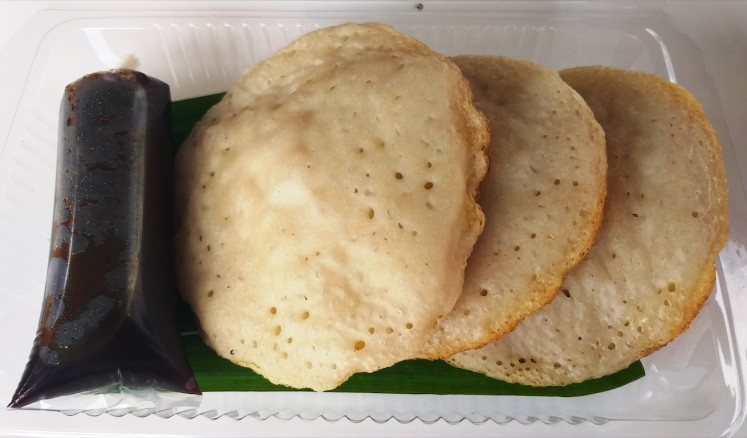Popular Reads
Top Results
Can't find what you're looking for?
View all search resultsPopular Reads
Top Results
Can't find what you're looking for?
View all search resultsTwenties: popular iftar dishes to break the fast
From cold to warm, sweet to savory, here are 20 of the most popular traditional treats eaten to break the fast in Indonesia.
Change text size
Gift Premium Articles
to Anyone
‘Twenties' is a new column in which we give our top 20 list of anything and everything of interest, from food and history to pop culture and lifestyle — and more.
Despite the requirement to fast all day long, Muslim Indonesians take out their best recipes during this holy month, flooding the market and street sides with rare treats for iftar. From cold to warm, sweet to savory, here are 20 of the most popular traditional treats eaten to break the fast in Indonesia.
1. Bubur Candil
Candil is a snack that comes from Java. However, these sweets are also available in Bali and Sulawesi under different names: Jaje batun bedil in Bali and katiri mandi in Sulawesi. Candil is often mistaken for biji salak. However, the main ingredients of the two are different.
The original candil recipe does not contain sweet potatoes, but only glutinous rice flour and water. These are kneaded, shaped into a small sphere, and boiled until cooked. Candil balls are served with a sauce made of coconut sugar and thick cooked coconut milk with pandan leaves as garnish, making the complete bubur candil. Sometimes, bubur candil is also served with traditional rice and coconut milk pudding called bubur sumsum.
2. Biji Salak
'Biji salak' by Denny Boy Gunawan, executive sous chef of The Westin Jakarta. (JP/Jessicha Valentina)Biji salak (lit. snakefruit seeds) is a unique Betawi cuisine that ironically does not contain salak at all. Biji salak is made from a mixture of finely mashed sweet potato with tapioca flour, which is then rounded and boiled until cooked. Traditionally orange-colored, biji salak made with purple sweet potatoes is also popular.
Often confused with bubur candil, biji salak is usually eaten with coconut sugar and coconut milk or compote sauce, kolak. Sometimes, biji salak is not the main star of the dish. Instead, it serves as a topping for many types of kolak compote, such as kolak singkong (cassava), kolak pisang (banana) or kolak kolang-kaling (sugar palm fruits).
3. Kolak
'Kolak' pisang or better known as banana 'kolak' (Santika Premiere ICE – BSD City/-)Kolak, often stylized as kolek in some regions, is an Indonesian dessert based on palm sugar, coconut milk and a variety of fruits and vegetables at the center of the dish, such as banana, cassava, sweet potatoes, pumpkins and even sugar palm fruit or jackfruit. Pandan leaf is also said to be one of its main ingredients, but some households might exclude this entirely or merely add the leaves for plating presentation.
There is a tale that this dish has an important role in the spread of Islamic teachings in Java by the ulema (the learned ones or scholars of Islam). Kolak is said to be derived from the word Khalik (the Creator of Heaven and Earth).
4. Es Pisang Ijo
Es pisang ijo is a banana-based dessert recipe from Makassar, South Sulawesi. Es pisang ijo (lit. green banana ice) is made from a specific banana type called pisang kepok wrapped in a green skin layer of rice flour, coconut milk, suji and pandan leaves.
The wrapped bananas are then cut into pieces and served with coco pandan syrup or Ambon banana syrup and rice-flour pudding.
5. Es Pallu Butung
Just like es pisang ijo, es pallu butung hails from Makassar. However, the dessert is associated with a more specific region because of its name. Pallu in the Makassar local language means cuisine, while butung is the term for the Bugis-Makassar people of the Buton region. Therefore, Pallu Buttung means "cuisine from Buton".
Es pallu butung is very similar to es pisang ijo. However, this dessert calls for pisang raja for its banana, and does not include the green outer layer. The pisang raja is sliced thickly, about five millimeters, and served with coco-pandan syrup or Ambon banana syrup and rice-flour pudding. The concoction is finally mixed with crushed ice.
6. Bubur Kampiun
From West Sumatra: Bubur Kampiun has a unique history as it is known to be a winning creation, but actually made out of leftovers. (JP/OHMG) (JP/OHMG)Originating in West Sumatra, bubur kampiun combines a variety of sweet compotes into one and thereby produces a rich taste. Bubur Kampiun usually consists of bubur sumsum, kolak pisang or kolak ubi, bubur kacang hijau, bubur ketan hitam and bubur candil.
It is said that this recipe was invented by a porridge seller named Amai Zona, who came late to the porridge creation competition in the city of Bukittinggi, West Sumatra. Because she was late, Amai Zona mixed a variety of porridges that she couldn't sell that day as her creation, and called it bubur kampiun (champion porridge). Unexpectedly, this creation won and is popular until now.
7. Mandai
Mandai is a typical food from Banjar, South Kalimantan, made from cempedak fruit skin fermented in a salt solution for a minimum of three days and a maximum of one month. Mandai is a substitute for fish for the people of Banjar, who are very fond of eating fish during the low-tide season. It tastes similar to cuttlefish.
The main ingredient of mandai is the inner skin of the cempedak, which looks like a cork. This fermentation process adds flavor and softens the skin of the fruit. Mandai can then be fried with shallots, garlic and chilies to be eaten as a snack or with warm rice.
8. Sekubal
Sekubal or segubal is a dish from the Lampung province, South Sumatra, which usually appears on special occasions, such as a typical Lampung wedding, or Ramadan and Eid. This dish, similar to a rice cake, is made from sticky rice and coconut milk and takes 8-10 hours to complete.
Sticky rice mixed with coconut milk is wrapped in leaves and steamed until it hardens enough. While hot, the sticky rice is shaped into spheres of the same size, then rearranged into one roll, with each piece separated by coin-shaped barriers made of banana leaves. After that, the sekubal rolls are steamed, boiled or grilled, then eaten with sticky rice as a dessert or with side dishes of rendang, opor or chili sauce.
9. Lemang
Rendang might be available all year long, but lemang is a rare treat, especially the original lemang bambu. The Minangkabau (an ethnic group from West Sumatra) traditional rice cake is made from glutinous rice, coconut milk and salt. The unique aspect is the cooking process which is said to be introduced by Sheikh Burhanuddin. The ingredients are wrapped with banana leaves and inserted into a hollowed bamboo tube. The savory mixture is then slowly roasted on an open fire for at least four hours.
Lemang or lamang is considered a special food, so much so that the Minangkabau have a tradition called malamang -- making lamang “just in time” before Ramadan, Eid or manjapuik marapulai ceremony (a procession to pick up the groom prior to marriage). It is also enjoyed in other regions, including Tapanuli, North Sumatra, and is known as lomang to the Batak (an ethnic group from North Sumatra).
10. Pakat Rotan
Some would say Indonesians would turn anything into food as long as they have sambal. The saying rings true for Pakat Rotan from North Sumatra. Instead of weaving rattan into furniture, some burn them inside a furnace filled with fiery charcoal. However, this dish requires only the soft young shoots of rattan, akin to bamboo shoots.
After 30 minutes inside the furnace, the outer layers are peeled and then washed. The slightly bitter dish is then served with red-hot sambal.
11. Es Pleret
Es pleret, also known as es gempol pleret in some regions, is a popular sweet cold dessert from Java. It is known to be a must-have Ramadan iftar treat in Blitar, East Java, and Magelang, Surakarta and Semarang, Central Java.
The name comes from the method of shaping the rice-flour balls, which are the highlight of the dish. After being rounded, the dough is then flattened with fingers -- a technique locally known as pleret. The cooked pleret are then served with raspberry syrup or juruh, watered coconut-sugar syrup. Some sellers would also add sago pearls, cendol or dawet to the icy drink.
12. Bolu Kojo
Sweet treat: Jejongkong (in a glass), the decadent Kue Lumpur and green Bolu Kojo are usually sold in the same stalls as they have similar ingredients. (JP/OHMG) (JP/OHMG)Bolu kojo is a sweet yet slightly savory treat from Palembang, South Sumatra, which has a texture akin to kue lumpur. The gooey yet dense cake's main ingredients are pandan leaves for their aroma, suji leaves for their deep green color and coconut milk for its richness.
The true bolu kojo is made individually in flower-shaped mini pans. This is how bolu kojo gets its name -- because it is shaped like frangipani flowers, locally called kemojo in several Sumatera regions, including Jambi, Riau and Bengkulu. Because it needs to be baked individually, bolu kojo becomes a special treat for special occasions, such as weddings and Ramadan.
13. Jalangkote
First things first: despite the similarity in appearance, jalangkote is not pastel. Jalangkote is a filling snack from Sulawesi, but most would say that it comes strictly from Makassar. It has a thinner outer crust than pastel, and instead of being served with green cayenne peppers, it goes with a watery sauce made out of vinegar and chili.
Jalangkote is filled with carrots, potatoes, rice vermicelli and meat -- chicken, duck, beef or even horse meat. These fillings are sauteed with salt, onions, garlic and pepper. However, the addition of nutmeg and cumin makes the flavor even more special. Some would also add slices of boiled egg into jalangkote, adding to its richness.
14. Apang Colo
'Apang Colo': It looks slightly like surabi. However, it has communal meanings for Gorontalo community and is treated as special dish for Ramadan. (Wikimedia Commons/Supardisahabu) (Wikimedia Commons/Supardisahabu)Indonesia has many versions of kue apem and apang colo, also known as apangi or kue kerawang, is one of them. The cake is native to Gorontalo, Sulawesi. Every Muharram, most traditional communities provide the cakes for free all month long during the Apangi Festival. It is also a popular iftar treat in the area that is enjoyed by dipping the cakes into palm sugar syrup. The red and white colors symbolize bravery and purity, respectively.
Apang colo is made by mixing wheat flour, rice flour, yeast and coconut milk. The dough is covered with a cloth until it rises, then placed into iron molds. After baking, the cakes have holes made from air bubbles due to the yeast, making its signature look.
15. Bubur Peca
Bubur peca is an iftar dish that comes from Samarinda, East Kalimantan. Despite its simplicity, the dish is known to be only served during Ramadan due to community habits. During Ramadan, Bugis communities in Samarinda Seberang gather in one place and cook the spicy porridge together to be eaten together at mosques or mushollas (prayer rooms).
The main ingredients of bubur peca are rice, coconut milk and chicken meat. However, these go with strong spices, such as shallots, garlic, ginger, turmeric, cinnamon and nutmeg. Pieces of chicken meat and crispy fried shallots are usually served as a topping, sometimes replaced or accompanied by fish, shrimp, meat or shellfish.
16. Bongko Kopyor
Bongko kopyor is a sweet dessert that highlights the taste of macapuno (in Tagalog, lit. characterized by being full) or coconut sport, locally known as kelapa kopyor. This is a typical iftar dish for people in Gresik, East Java, which combines the sweetness of jackfruit, sago pearls, coconut milk, banana and bread.
The ingredients are wrapped in banana leaf and steamed for a few minutes. The special mixture for the coconut milk, which is usually thickened with cornstarch, makes the bubur (porridge) after the steaming process.
17. Getuk Pisang
Getuk, often stylized as gethuk, is a dish commonly made from cassava, sweet potato or breadfruit. However, in Kediri, East Java, banana is the main ingredient. Getuk Pisang is made from steamed bananas, specifically pisang raja. Pisang raja has the appropriate texture to make the dish, as it is not too watery.
The bananas are steamed, mashed and mixed with sugar and a little bit of salt. Then, they are wrapped in banana leaves, usually in the shape similar to a small lontong, and steamed again. Unlike other types of getuk, getuk pisang has the addictive sour aftertaste.
18. Jejongkong
From West Sumatra: Bubur Kampiun has a unique history as it is known to be a winning creation, but actually made out of leftovers. (JP/OHMG) (JP/OHMG)Jejongkong, jojongkong or simply jongkong, is a sweet treat from Bandar Lampung, Lampung, South Sumatra. It was brought by Chinese immigrants and can be served cold or warm. It is common in some areas where descendants of the original Chinese immigrants reside, but for most, jejongkong is a treat people can only find during Ramadan.
Jejongkong is a dessert made from rice flour, tapioca flour and rice starch. The gooey pudding made from this mixture is then served with a mixture of palm sugar syrup and coconut milk. The flesh of young coconuts is also a common topping for the dish.
19. Srikaya
In addition to bolu kojo, Palembang shares another green delight called srikaya or srikayo. The decadent dessert is made with only sugar, coconut milk and egg. The process and texture are similar to Japanese chawanmushi.
The ingredients are mixed with pandan and suji extract for their vibrant green color, but this is optional. After steaming in small cups, the mixture is set. Palembangnese would then enjoy the delicate pudding with sticky rice cakes or a slice of bread.
20. Asida
Asida is a unique treat. Some say that it is a cake, and some would call it a pudding or even dodol. It is a popular treat in Ambon, Maluku, but it is actually a Middle Eastern dessert. The original recipe calls for dough from wheat flour and hot water, topped with savory butter or honey.
In Ambon, the dough is also mixed with palm sugar and then slathered in butter and refined sugar. At once sweet and savory, asida is also aromatic since it also contains pandan extract and cardamom.
ohmg

